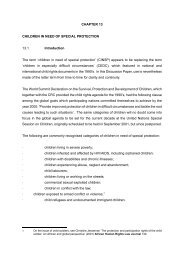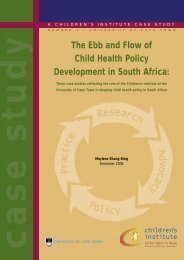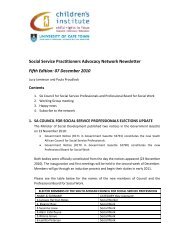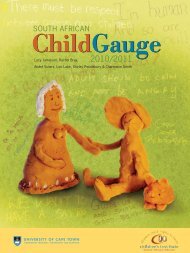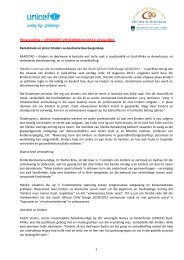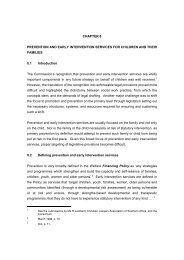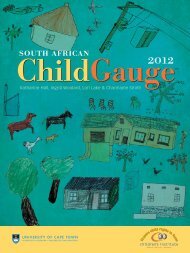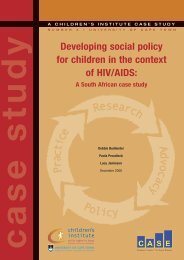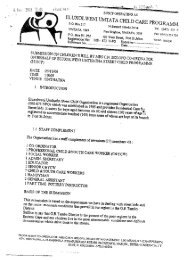An essential package of services and support for ECD - Children's ...
An essential package of services and support for ECD - Children's ...
An essential package of services and support for ECD - Children's ...
Create successful ePaper yourself
Turn your PDF publications into a flip-book with our unique Google optimized e-Paper software.
Getting the basics right: <strong>An</strong> <strong>essential</strong> <strong>package</strong> <strong>of</strong><strong>services</strong> <strong>and</strong> <strong>support</strong> <strong>for</strong> <strong>ECD</strong>Lizette Berry (Children’s Institute), <strong>An</strong>drew Dawes (Department <strong>of</strong> Psychology, University <strong>of</strong> Cape Town <strong>and</strong> Ilifa Labantwana) <strong>and</strong>Linda Biersteker (Early Learning Resource Unit)South Africa sits on the cusp <strong>of</strong> a new dispensation. TheNational Development Plan (NDP) 1 recognises investment inearly childhood development (<strong>ECD</strong>) <strong>and</strong> education as centralin building a more developed <strong>and</strong> productive society by 2030. Theprioritisation <strong>of</strong> <strong>ECD</strong> in the NDP provides an opportunity to fashionthe next generation <strong>of</strong> South Africa’s citizens, <strong>and</strong> improve thenation’s economic, social <strong>and</strong> political environment.Over the next 17 years, South Africa has a unique opportunity todo things differently, <strong>and</strong> to ensure that children born in 2013 willbe far better equipped <strong>for</strong> a productive adult life by 2030. At thesame time, a child rights lens dem<strong>and</strong>s a focus beyond children’spotential contribution to the adult work<strong>for</strong>ce, <strong>and</strong> the recognition,promotion <strong>and</strong> nurturing <strong>of</strong> their intrinsic value <strong>and</strong> abilities asyoung citizens. How do we seize the opportunity? <strong>An</strong>d where dowe start?This South African Child Gauge recognises that child developmentbegins be<strong>for</strong>e birth, <strong>and</strong> outlines a <strong>package</strong> <strong>of</strong> <strong>essential</strong> <strong>services</strong><strong>and</strong> <strong>support</strong> from conception to early schooling aligned withnational policy <strong>and</strong> international child rights instruments. iThis essay responds to the following questions:• Why is early childhood a critical stage?• Why should <strong>ECD</strong> be prioritised in South Africa?• What are <strong>ECD</strong> <strong>services</strong>?• Delivery is a major challenge – where do we start?• How are <strong>essential</strong> <strong>ECD</strong> <strong>services</strong> <strong>and</strong> <strong>support</strong> deliveredappropriately?Why is early childhood a critical stage?Recent research reaffirms the significance <strong>of</strong> <strong>ECD</strong> in determiningfuture health, behaviour <strong>and</strong> learning. 2 The first 1,000 days <strong>of</strong> life(from conception to two years old) is a particularly sensitive <strong>and</strong>rapid period <strong>of</strong> development. Healthy brain development largelydepends on the quality <strong>of</strong> the environment be<strong>for</strong>e birth <strong>and</strong> in thefirst 24 months. 3 Infants <strong>and</strong> young children develop best whencaring adults respond with love, warmth <strong>and</strong> consistency, providingopportunities <strong>for</strong> interaction <strong>and</strong> learning. 4Poverty <strong>and</strong> related problems such as poor health <strong>and</strong> nutrition,deficient care, <strong>and</strong> limited stimulation – particularly when they acttogether – have negative effects on early development. 5 Thesefactors can contribute to a trajectory <strong>of</strong> poor health <strong>and</strong> schoolingoutcomes that perpetuate the cycle <strong>of</strong> poverty. 6However, protective influences such as good nutrition, healthcare, <strong>support</strong>ive parenting <strong>and</strong> opportunities <strong>for</strong> early learningcan nurture positive development – including good health <strong>and</strong>academic outcomes, economic productivity, responsible citizenship<strong>and</strong> effective parenting <strong>of</strong> the next generation. 7 Such opportunitiesmust be maximised <strong>for</strong> children in poverty who bear the brunt <strong>of</strong>developmental risks 8 <strong>and</strong> who have been shown to benefit mostfrom <strong>ECD</strong> interventions 9 .Why should <strong>ECD</strong> be prioritised in South Africa?Early childhood is a vulnerable period <strong>and</strong> a <strong>support</strong>ive livingenvironment <strong>and</strong> enabling social <strong>and</strong> political context arefundamental to ensure children’s sound development.Multiple risks affect young children’s developmentYoung children ii in South Africa grow up in a pr<strong>of</strong>oundly unequalsociety 10 in which poverty threatens the sound early development<strong>of</strong> the majority <strong>of</strong> children. Exposure to crime <strong>and</strong> violenceis significant 11 <strong>and</strong> South Africa’s under-five mortality rate isinordinately high <strong>for</strong> a middle-income country 12 . Malnutrition, HIV<strong>and</strong> childhood illnesses remain key drivers <strong>of</strong> under-five mortality. 13Many <strong>of</strong> these deaths can be avoided through simple <strong>and</strong> timelyresponses. While South Africa has, in recent years, experienceda decline in child mortality rates due to significant take-up in HIVprevention <strong>and</strong> treatment programmes, a large number <strong>of</strong> childrenare living with HIV. 14Unfavourable environmental conditions such as poor housinginfrastructure, lack <strong>of</strong> access to adequate water, sanitation facilities<strong>and</strong> poor hygiene in the home contribute to infections <strong>and</strong> disease,particularly in young children. Malnutrition, childhood illness <strong>and</strong>a lack <strong>of</strong> early stimulation continue to compromise children’scognitive development <strong>and</strong> later school per<strong>for</strong>mance.Table 1 starkly presents the multiple risks <strong>and</strong> vulnerabilitieschildren are exposed to early in life. If the NDP’s vision is to berealised, access to sound programmes that nurture children’s basichealth <strong>and</strong> nutrition, improve their living environments, <strong>support</strong>caregivers, <strong>of</strong>fer stimulation <strong>for</strong> early learning, <strong>and</strong> provide referralsto appropriate health care <strong>and</strong> social <strong>services</strong> 15 are <strong>essential</strong>.iiiFor example: the United Nations Convention on the Rights <strong>of</strong> the Child <strong>and</strong> related General Comment No. 7: Implementing Children’s Rights in Early Childhood; the African Charter on the Rights<strong>and</strong> Welfare <strong>of</strong> the Child; White Paper 5 on Early Childhood Education; the National Integrated Plan <strong>for</strong> <strong>ECD</strong> 2005 – 2010, <strong>and</strong> the National Plan <strong>of</strong> Action <strong>for</strong> Children.In this essay, the term “young children” refers to children from birth to 9 years old (inclusive), unless stated otherwise.26South African Child Gauge 2013
National policy imperativesThe state has put in place a number <strong>of</strong> laws, policies <strong>and</strong> programmesacross a range <strong>of</strong> government departments to improve the lives <strong>of</strong>young children. iii However, a recent review 16 indicates that current<strong>services</strong> are not sufficient to prevent many <strong>of</strong> the risks faced bychildren, or to promote their optimal development.Government is exploring new strategies to respond to thesechallenges <strong>and</strong> to ensure that the most vulnerable young childrenare reached with quality <strong>services</strong>. For example, the Department<strong>of</strong> Social Development hosted an inaugural <strong>ECD</strong> conference in2012, which resulted in an Integrated Programme <strong>of</strong> Action <strong>for</strong> <strong>ECD</strong>2013 – 2018. Other processes that fed into the development <strong>of</strong>this programme were a review <strong>of</strong> the National Integrated Plan <strong>for</strong><strong>ECD</strong> 2005 – 2010 (NIP <strong>for</strong> <strong>ECD</strong>), <strong>and</strong> the <strong>ECD</strong> Diagnostic Review 17 .The primary health care re-engineering strategy has a strong focuson improving maternal <strong>and</strong> child health <strong>and</strong> on school healthpromotion, while the NDP recognises the development <strong>of</strong> youngchildren as a national priority. These mark critical opportunities<strong>for</strong> improving <strong>and</strong> extending the reach <strong>and</strong> quality <strong>of</strong> existinginterventions through effective implementation.What are <strong>ECD</strong> <strong>services</strong>?There are a broad range <strong>of</strong> <strong>services</strong> to promote or <strong>support</strong> thedevelopment <strong>of</strong> young children <strong>and</strong> respond to their needs acrossinterdependent developmental areas: physical, social, emotional,language <strong>and</strong> cognitive. 18 Progress or otherwise in one area islikely to affect that in others. For example, children experiencingmalnutrition in the first two years <strong>of</strong> life are likely to underper<strong>for</strong>macademically. 19 The multidimensional nature <strong>of</strong> early developmentrequires that multiple role-players, with different skills <strong>and</strong>expertise, deliver a range <strong>of</strong> <strong>services</strong> to young children to ensureall-round development.South African policy <strong>and</strong> law encapsulate a broad view <strong>of</strong> serviceprovision <strong>and</strong> recognise the need <strong>for</strong> a multisectoral approachacross health, education, social protection <strong>and</strong> socio-economicdevelopment. Services are provided by a range <strong>of</strong> governmentdepartments (eg Health, Social Development <strong>and</strong> Basic Education),non-pr<strong>of</strong>it organisations <strong>and</strong> the private sector. The NIP <strong>for</strong> <strong>ECD</strong><strong>and</strong> the Integrated Programme <strong>of</strong> Action <strong>for</strong> <strong>ECD</strong> 2013 – 2018recognise the need <strong>for</strong> a multisectoral approach through a variety<strong>of</strong> service delivery channels, including homes, communities <strong>and</strong>Table 1: The status <strong>of</strong> young children (0 – 9 years*) in South AfricaDomain Measure Number, rate or proportionChild population Number <strong>of</strong> young children a 10,127,000Income povertyYoung children living in households with a monthly per capita income<strong>of</strong> less than R604 b58%Rural status Young children living in rural areas c 45%Child mortality Under-five mortality rate d 42 per 1,000 live birthsMalnutrition Children under three years who are stunted e 27%Disability <strong>and</strong> chronic illnessEstimated child disability prevalence rate (moderate-to-severedisability among all children) f4 – 6%National mother-to-child HIV transmission rate g 3%Childhood infections Incidence <strong>of</strong> pneumonia (cases in children under five years <strong>of</strong> age) h 84 per 1,000 childrenIncidence <strong>of</strong> diarrhoea with dehydration (cases in children under fiveyears <strong>of</strong> age) i15.2 per 1,000 childrenEarly schooling Average score <strong>for</strong> grade 3 mathematics j 41%Average score <strong>for</strong> grade 3 literacy k 52%* This st<strong>and</strong>ard age group applies <strong>for</strong> all measures, except where stated otherwise.Sources: a., b. & c. K Hall analysis <strong>of</strong> General Household Survey 2011, Children’s Institute, UCT.d. Bradshaw D, Dorrington RE & Laubscher R (2012) Rapid Mortality Surveillance Report 2011. Cape Town: Medical Research Council.e. Shisana O, Labadarios D, Rehle T, Simbayi L, Zuma K, Dhansay A, Reddy P, Parker W, Hoosain E, Naidoo P, Hongoro C, Mchiza Z, Steyn NP, Dwane N, Makoae M, Maluleke T, Ramlagan S, Zungu N,Evans MG, Jacobs L, Faber M, & SANHANES-1 Team (2013) South African National Health <strong>and</strong> Nutrition Examination Survey (SANHANES-1). Cape Town: HSRC Press.f. Philpott S (2010) Scorecard 2011: Inclusion <strong>of</strong> an Indicator on Developmental Screening. Document compiled <strong>for</strong> the Yezingane Network. Pietermartizburg: Disability Action Research Team.g. Goga A, Dinh TH, Jackson D, Lombard C, Crowley, S. Sherman G, Puren A, Woldesenbet S, Solomon W, Ramokolo V, Koopman F, Dlamini N & Pillay Y & the South Africa PMTCT Evaluation Team (2012)Impact <strong>of</strong> the National Prevention <strong>of</strong> Mother-to-Child Transmission <strong>of</strong> HIV (PMTCT) Programme on Perinatal Mother-to-Child Transmission <strong>of</strong> HIV (MTCT) Measured at 6 Weeks Postpartum, SouthAfrica (SA): Results <strong>of</strong> the First Year <strong>of</strong> Implementation <strong>of</strong> the 2010 PMTCT Guidelines Recommended by the World Health Organization (WHO). Presented at the XIX International AIDS Conference,Washington DC, July 2012.h. & i. Department <strong>of</strong> Health (2012) District Health In<strong>for</strong>mation System. In: Bam<strong>for</strong>d L (2013) Maternal, newborn <strong>and</strong> child health. In: Padarath A & English R (eds) South African Health Review 2012/13.Durban: Health Systems Trust.j. & k. Department <strong>of</strong> Basic Education (2012) Report on the <strong>An</strong>nual National Assessments 2012. Pretoria: DBE.iiiFor example, the Children’s Act (38 <strong>of</strong> 2005); the National Integrated Plan <strong>for</strong> <strong>ECD</strong> 2005 – 2010, free health care <strong>for</strong> children under six years <strong>and</strong> their mothers; the roll-out <strong>of</strong> antiretroviraltreatment; the National School Nutrition Programme; the introduction <strong>and</strong> roll-out <strong>of</strong> grade R; <strong>and</strong> many other programmes.PART 2Essential <strong>services</strong> <strong>for</strong> young children27
facilities (eg <strong>ECD</strong> centres). Primary caregivers iv remain central inproviding a healthy, nurturing <strong>and</strong> stimulating environment 20 <strong>and</strong>further attention should be given to how external service providerscan best <strong>support</strong> primary caregivers to fulfil their roles.South Africa has made positive strides in certain service areassince the late 1990s, as illustrated in table 2. Improvements inthe provision <strong>of</strong> basic <strong>services</strong> are significant (also see Part three:Children Count – The Numbers on pp. 84 – 114). Largely due tooverall improved birth certificate registration, approximately6.6 million young children are accessing the Child Support Grant(CSG), 21 the country’s primary child poverty alleviation programme.Access to educational <strong>and</strong> early learning opportunities hasincreased substantially in recent years. However, the academicper<strong>for</strong>mance <strong>of</strong> young learners in the foundation phase <strong>of</strong> the publiceducation system is less than satisfactory (see table 1). Learning iscumulative, <strong>and</strong> urgent attention must be given to improving theTable 2: Progress in <strong>ECD</strong> service deliveryService Measure Progress Access, equity <strong>and</strong> qualityMaternal <strong>and</strong> child health <strong>An</strong>tenatal care In 2011, 40% <strong>of</strong> pregnant women attended antenatal visits early, be<strong>for</strong>e 20 weeks. aWomen attending antenatal care on average only attend three visits. aOverall coverage is high, at over 90%. 22ImmunisationHIV testingIn 2011, 95% <strong>of</strong> one-year-olds were fully immunised. Significant provincial <strong>and</strong> districtdisparities exist. bIn 2011, 63% <strong>of</strong> HIV-exposed infants received a PCR test v at eight weeks. cInfants living in rural districts are less likely to get tested. 23Nutrition Breastfeeding In 2003, 8% <strong>of</strong> infants were exclusively breastfed <strong>for</strong> the first six months. dSubsequently, a 2008 survey suggested 26%, but the sample was very small. 24Birth registration <strong>and</strong>social grantsVitamin ABirth registrationIn 2011, 43% <strong>of</strong> children 1 – 5 years received vitamin A supplements. eProvincial variation is a concern, 25 <strong>and</strong> malnutrition is highest in rural <strong>and</strong> urbanin<strong>for</strong>malareas, <strong>and</strong> in children under three years 26 .In 2011/12, 90% <strong>of</strong> births were registered within the year <strong>of</strong> birth. fIn 2008, 90% <strong>of</strong> 0 – 9-year-olds had a birth certificate, while only 11% <strong>of</strong>0 – 3-year-olds did not. gIn 2011, only 11% <strong>of</strong> children under three years were not birth registered. 27Early learningChild Support Grant(CSG)Access to earlylearning <strong>and</strong> <strong>support</strong><strong>for</strong> children aged 0 – 4yearsAccess to earlylearning <strong>for</strong> childrenaged 5 – 6 yearsAccess to earlyschooling <strong>for</strong> childrenaged 7 – 9 yearsIn 2011, 6.6 million young children received the CSG. Access is lower <strong>for</strong> childrenunder three years. hIn 2012, 485,500 children under five years received a subsidy at an <strong>ECD</strong> centre. iHowever, there are age, geographic, race <strong>and</strong> income disparities. 28In 2011, 89% <strong>of</strong> 5 – 6-year-olds attended an <strong>ECD</strong> centre or <strong>for</strong>mal school. j735,000 children attended school-based grade R classes 29 while others attendedcommunity-based <strong>ECD</strong> centres. Quality remains a challenge. 30In 2011, 99% <strong>of</strong> 7 – 9-year-olds attended school. Quality <strong>and</strong> educational outcomesare a concern. kKey: Insufficient progress Some progress, needs attention Good progressSources: a. Department <strong>of</strong> Health (2012) District Health In<strong>for</strong>mation System, 2011 data. In: Bam<strong>for</strong>d L (2013) Maternal, newborn <strong>and</strong> child health. In: Padarath A & English R (eds) South AfricanHealth Review 2012/13. Health Systems Trust.b. Health Systems Trust (2011) Health indicators. Immunisation coverage <strong>of</strong> children
quality <strong>of</strong> interventions <strong>for</strong> young children <strong>and</strong> to underst<strong>and</strong>ingthe relationship between early development <strong>and</strong> learning <strong>and</strong> itsimpact on academic per<strong>for</strong>mance in later childhood.Children living in poverty <strong>and</strong> rural areas, <strong>and</strong> those withdisabilities, generally struggle to access quality <strong>services</strong>. 31While remarkable progress has been made to improve access toa range <strong>of</strong> <strong>essential</strong> <strong>services</strong> among the most disadvantaged, gaps<strong>and</strong> inequitable provision persist. Priorities <strong>for</strong> intervention are: 32• Parenting <strong>support</strong>, especially <strong>for</strong> 0 – 2 years.• Maternal health <strong>and</strong> well-being, including nutrition duringpregnancy <strong>and</strong> breastfeeding.• Child health <strong>and</strong> nutrition.• Safe <strong>and</strong> af<strong>for</strong>dable child care <strong>for</strong> families who need it.• Educational stimulation opportunities <strong>for</strong> those not in earlylearning facilities (the majority <strong>of</strong> the poorest children), includingchildren with disabilities.These <strong>and</strong> other challenges need urgent attention. If disadvantagedchildren do not receive appropriate interventions early enough <strong>and</strong>their environments remain unchanged, they are likely to endurelifelong consequences, 33 <strong>and</strong> the vision <strong>of</strong> the NDP <strong>for</strong> South Africain 2030 will simply not be realised.Delivery is a major challenge – where do we start?While universal provision <strong>of</strong> a full range <strong>of</strong> <strong>services</strong> to address allchildren’s developmental needs is optimal, it is too challenging atask given limited resources. A service delivery approach is requiredthat aligns with current policy, is evidence based, <strong>and</strong> capable <strong>of</strong>reducing risks while promoting the capacities <strong>of</strong> young children. Ineffect, an approach which defines <strong>and</strong> ensures <strong>essential</strong> <strong>services</strong>.The NIP <strong>for</strong> <strong>ECD</strong> provides a useful starting point by identifyinga range <strong>of</strong> core <strong>services</strong> <strong>for</strong> children younger than five years,targeting the most vulnerable children <strong>and</strong> households, <strong>and</strong>building on existing <strong>services</strong> in health, social development <strong>and</strong>education. 34 This view is <strong>support</strong>ed in other policies, such as theIntegrated Programme <strong>of</strong> Action <strong>for</strong> <strong>ECD</strong> 2013 – 2018.However, there is a need to go further – to consolidate <strong>and</strong> exp<strong>and</strong>the intentions <strong>of</strong> the NIP <strong>and</strong> provide concrete recommendations<strong>for</strong> a well-defined <strong>package</strong> <strong>of</strong> <strong>services</strong> <strong>and</strong> <strong>support</strong> <strong>for</strong> childrenaged 0 – 9 years in poor households.Figure 1: Examples <strong>of</strong> a developmentally-appropriate continuum <strong>of</strong> early childhood <strong>services</strong>Early antenatalbooking,nutritional<strong>support</strong> inpregnancy,maternal mentalhealth screeningBirth registration,social grantaccess, breastfeeding,health &nutritional<strong>support</strong>,immunisation,developmentalscreening,caregiver <strong>support</strong>Infancy(birth – 2 years)Quality earlylearningprogrammes,parentingeducation, health& nutritional<strong>support</strong>Pre-school(3 – 4 years)Quality education,<strong>services</strong> <strong>for</strong>children withdisabilities,health &nutritional<strong>support</strong>Foundation phase(5 – 9 years)PregnancySource: Adapted from: Richter L, Biersteker L, Burns J, Desmond C, Feza N, Harrison D, Martin P, Saloojee H & Slemming W (2012) Diagnostic Review <strong>of</strong> Early Childhood Development. Pretoria:Department <strong>of</strong> Per<strong>for</strong>mance, Monitoring <strong>and</strong> Evaluation & Inter-Departmental Steering Committee on <strong>ECD</strong>.PART 2Essential <strong>services</strong> <strong>for</strong> young children29
<strong>An</strong> <strong>essential</strong> <strong>package</strong> <strong>of</strong> <strong>services</strong> <strong>and</strong> <strong>support</strong>This section presents a proposed “<strong>essential</strong> <strong>package</strong> <strong>of</strong> <strong>ECD</strong><strong>services</strong> <strong>and</strong> <strong>support</strong>” (the <strong>essential</strong> <strong>package</strong>), drawing heavily onthe work <strong>of</strong> Ilifa Labantwana vi . 35Different inputs are required at various stages <strong>of</strong> a child’sdevelopment. It is there<strong>for</strong>e necessary to build a continuum<strong>of</strong> <strong>services</strong> appropriate to the stages <strong>of</strong> development, fromconception throughout pregnancy through to the first years <strong>of</strong>school (see figure 1 on p. 29).The examples <strong>of</strong> <strong>services</strong> illustrated in figure 1 can be clusteredin five basic components. These make up the notion <strong>of</strong> an <strong>essential</strong><strong>package</strong>:1. Nutritional <strong>support</strong>2. Social <strong>services</strong>3. Maternal <strong>and</strong> child health <strong>services</strong>4. Support <strong>for</strong> primary caregivers5. Stimulation <strong>for</strong> early learningSuch an <strong>essential</strong> <strong>package</strong> <strong>of</strong> <strong>services</strong> must be viewed within thecontext <strong>of</strong> a broader set <strong>of</strong> provisions such as poverty alleviation,food security, basic household <strong>services</strong> <strong>and</strong> violence preventionthat create an environment conducive to young children’sdevelopment. 36The proposed <strong>essential</strong> <strong>package</strong> includes <strong>services</strong> that arealready m<strong>and</strong>ated in policy <strong>and</strong> law, only adding others wherethere are gaps that must be filled, as indicated by evidence.Each component <strong>of</strong> the proposed <strong>essential</strong> <strong>package</strong> is outlinedin figure 2.Nutritional <strong>support</strong> <strong>for</strong> mothers <strong>and</strong> childrenPoor nutrition in young children is a serious health concern in SouthAfrica. The first 1,000 days <strong>of</strong> life are most critical <strong>for</strong> nutritional<strong>support</strong> to ensure optimal growth <strong>and</strong> development. The StrategicPlan <strong>for</strong> Maternal, Newborn, Child <strong>and</strong> Women’s Health <strong>and</strong>Nutrition 2012 – 2016 37 <strong>and</strong> the new Infant <strong>and</strong> Young Child FeedingPolicy 38 are two key policies providing a framework <strong>for</strong> <strong>essential</strong>nutrition <strong>services</strong>.Social <strong>services</strong>Timely birth registration enables access to other <strong>services</strong> suchas social grants, free health care <strong>and</strong> education. Access to socialgrants is associated with improved nutrition, 39 <strong>and</strong> there<strong>for</strong>e takeupneeds to be strengthened in the first year <strong>of</strong> life.Social <strong>services</strong> are a vital <strong>support</strong> to families <strong>and</strong> children,including prevention <strong>and</strong> protection from abuse <strong>and</strong> neglect. Manychildren in South Africa experience violence, abuse, neglect <strong>and</strong>the loss <strong>of</strong> caregivers, <strong>and</strong> psycho-social <strong>support</strong> <strong>services</strong> may beneeded to help children cope with grief, loss <strong>and</strong> trauma.Maternal <strong>and</strong> child health <strong>services</strong>Early development begins at conception, <strong>and</strong> maternal <strong>and</strong> childhealth <strong>services</strong> are crucial <strong>for</strong> laying the foundation <strong>for</strong> optimalmaternal health <strong>and</strong> child development. Primary level <strong>services</strong> <strong>for</strong>pregnant women <strong>and</strong> young children serve to prevent illnesses,<strong>and</strong> promote good care <strong>and</strong> nutrition. Early intervention is <strong>essential</strong>to minimise risks <strong>and</strong> prevent develpoment delay <strong>and</strong> disability.Support <strong>for</strong> primary caregiversSupport <strong>for</strong> primary caregivers includes in<strong>for</strong>mation sharing onparenting <strong>and</strong> psycho-social <strong>support</strong>. Many caregivers living inpoverty carry significant burdens <strong>of</strong> care. Depression is common<strong>and</strong> may compromise their capacity to care <strong>for</strong> young children. 40Psycho-social <strong>support</strong> <strong>for</strong> caregivers is there<strong>for</strong>e <strong>essential</strong> topromote the well-being <strong>of</strong> caregivers <strong>and</strong> to reduce the risk <strong>of</strong> poorcaregiving. In addition, the Children’s Act 41 provides <strong>for</strong> parentingprogrammes that <strong>support</strong> parents to provide responsive care <strong>for</strong>young children.Safe <strong>and</strong> af<strong>for</strong>dable child care (including after-care <strong>for</strong> schoolagechildren) provides much needed <strong>support</strong> <strong>for</strong> caregivers whowork, study or are unable to care <strong>for</strong> their children.Stimulation <strong>for</strong> early learningAccess to quality early learning stimulation prior to grade Rsignificantly enhances the ability <strong>of</strong> children from impoverishedbackgrounds to benefit from schooling. 42 Early development <strong>and</strong>learning are inextricably tied to nurturing contexts <strong>and</strong> the home isthere<strong>for</strong>e a key site <strong>for</strong> intervention. 43Readiness to learn is not solely an outcome <strong>of</strong> engagement inearly learning opportunities. Children should also be demonstratingtheir emerging ability to exercise self-control, concentrate, <strong>and</strong> plan<strong>and</strong> reflect on their actions by the time they enter school. 44 A range<strong>of</strong> early learning opportunities are available be<strong>for</strong>e school <strong>and</strong> canbe delivered through home visiting, community playgroups, toylibraries <strong>and</strong> centre-based programmes.Stimulation <strong>for</strong> early learning prior to the foundation phase<strong>of</strong> <strong>for</strong>mal schooling is not enough. Quality education is crucialthroughout the foundation phase to improve outcomes <strong>and</strong>prepare learners <strong>for</strong> later schooling.viIlifa Labantwana is a multi-donor partnership which develops models <strong>for</strong> scaling up integrated <strong>ECD</strong> in South Africa.30South African Child Gauge 2013
Figure 2: Essential <strong>services</strong> <strong>for</strong> young children<strong>An</strong> <strong>essential</strong> <strong>package</strong> <strong>of</strong> <strong>services</strong> <strong>and</strong> <strong>support</strong>Nutritional <strong>support</strong>Mothers1. Mothers are provided with education onbreastfeeding <strong>and</strong> nutrients <strong>for</strong> children.2. Eligible women are provided with nutritional<strong>support</strong> during <strong>and</strong> after pregnancy.Children1. Children who fail to thrive vii are provided withnutritional <strong>support</strong>.2. Children are dewormed every six months from theage <strong>of</strong> 12 months.Social <strong>services</strong>1. Children’s births are registered as soon aspossible (preferably at birth).2. Eligible children access the appropriate socialgrants, particularly in the first year <strong>of</strong> life.3. Children are provided with a responsive childprotection service in which child abuse <strong>and</strong>neglect investigations are timeously conducted<strong>and</strong> concluded, <strong>and</strong> <strong>support</strong> is provided tovictims.4. Eligible children (particularly those affected bytrauma) are provided with psycho-social <strong>support</strong>.Maternal <strong>and</strong> child health <strong>services</strong>Mothers1. Pregnant women are provided with basic antenatal care(at least four antenatal visits, with the first antenatalvisit prior to 20 weeks <strong>of</strong> pregnancy).2. Pregnant women are screened <strong>for</strong> mental health <strong>and</strong>alcohol <strong>and</strong> substance abuse problems to provide<strong>support</strong> <strong>and</strong> prevent foetal damage. viii3. Pregnant women <strong>and</strong> mothers <strong>of</strong> young children arein<strong>for</strong>med on the dangers <strong>of</strong> smoking, alcohol <strong>and</strong> druguse, <strong>and</strong> neglect.4. Prevention <strong>of</strong> mother-to-child transmission (PMTCT)treatment is provided according to delivery protocols.Children1. Newborn health is promoted through postnatal carewithin six days <strong>of</strong> delivery (at a health facility or athome).2. Children who fail to thrive are screened <strong>for</strong>tuberculosis.3. Children are screened <strong>for</strong> developmental delay <strong>and</strong>disability at a health facility at 0 – 6 weeks;9 months; <strong>and</strong> 12 months. ix4. Children are routinely immunised.5. Primary health care facility staff are equipped toimplement the Integrated Management <strong>of</strong> ChildhoodIllness strategy.Support <strong>for</strong> primary caregivers1. Caregivers have access to parentingin<strong>for</strong>mation to reduce risk behaviour,improve their knowledge <strong>of</strong> early childhood,<strong>and</strong> promote parenting skills.2. Eligible primary caregivers (particularlythose burdened <strong>and</strong> depressed) areprovided with psycho-social <strong>support</strong>.3. Child care <strong>services</strong> are monitored <strong>and</strong>subsidised <strong>services</strong> are available.Stimulation <strong>for</strong> early learning1. Children have access to quality evidencebasedearly learning programmes prior tograde R.2. Children have access to communityresources that <strong>support</strong> early learningwithin the home (eg toy <strong>and</strong> booklibraries).3. Children have access to quality grade R<strong>and</strong> foundation phase education.vii “Failure to thrive” refers to children who do not gain weight as expected, or continue to lose weight.viii This service, with accompanying referral, is largely unavailable. Every ef<strong>for</strong>t must be made to provide this <strong>essential</strong> service.ix Urgent attention needs to be given to the provision <strong>of</strong> appropriate <strong>services</strong> <strong>for</strong> identified children.PART 2Essential <strong>services</strong> <strong>for</strong> young children31
Figure 3: Age-appropriate service delivery by locationSchoolsCentresPlaygroupsClinicsHomesPregnancy 0 1 2 3 4 5 6 7 8 9Age in years© <strong>An</strong>dré Viviers, UNICEF South Africa.How are <strong>essential</strong> <strong>services</strong> <strong>and</strong> <strong>support</strong> deliveredappropriately?Poor <strong>and</strong> vulnerable adults should not have to spend money <strong>and</strong>time to access basic <strong>services</strong>, so it is important to design <strong>services</strong>that are convenient <strong>and</strong> easily accessible. The design <strong>of</strong> <strong>services</strong>should there<strong>for</strong>e take into account where young children arelocated <strong>and</strong> which delivery channels will be most effective inreaching the majority <strong>of</strong> children, prioritising children who live inpoverty, rural areas <strong>and</strong> those with disabilities.On the basis <strong>of</strong> current evidence, the most appropriate deliverychannels – particularly <strong>for</strong> vulnerable <strong>and</strong> hard-to-reach families –are proposed in figure 3.Services should also be age-appropriate <strong>and</strong> respond tochildren’s changing needs as they grow <strong>and</strong> develop. For example,most young children are cared <strong>for</strong> within the home, <strong>and</strong> homecare is, in fact, desirable <strong>for</strong> children younger than three years. 45Essential <strong>services</strong> are there<strong>for</strong>e best delivered through multipledelivery channels, including:1. Home-based strategies (<strong>support</strong> <strong>for</strong> child <strong>and</strong> caregiver)2. Community-based strategies (eg playgroups, mobile clinics)3. Facility-based strategies (eg community health centres, <strong>ECD</strong>centres)ConclusionEarly childhood <strong>services</strong> present critical opportunities to invest<strong>and</strong> intervene in the lives <strong>of</strong> young children as early as possibleto minimise developmental risks <strong>and</strong> strengthen protectivefactors. Within current service delivery constraints <strong>and</strong> challenges,innovative approaches must be adopted to ensure that <strong>services</strong>reach the most vulnerable children <strong>and</strong> households.A <strong>package</strong> <strong>of</strong> <strong>essential</strong> <strong>services</strong>, aligned with current policy,is recommended as the vehicle <strong>for</strong> cost-effective <strong>and</strong> efficientdelivery that maximises opportunities <strong>for</strong> early childhoodinterventions. The essays that follow draw on this notion <strong>of</strong> an<strong>essential</strong> <strong>package</strong> <strong>of</strong> <strong>services</strong> <strong>and</strong> <strong>support</strong>, highlighting criticalchallenges <strong>and</strong> opportunities to improve the reach <strong>and</strong> quality <strong>of</strong><strong>services</strong> <strong>for</strong> South Africa’s most vulnerable young children.Early intervention <strong>and</strong> inclusion helps children with disabilitiesreach their full potential.32South African Child Gauge 2013
References1 The Presidency (2012) National Development Plan 2030. Our Future – Make it Work.Pretoria: National Planning Commission.2 Center on the Developing Child (2007) A Science-Based Framework <strong>for</strong> Early ChildhoodPolicy: Using Evidence to Improve Outcomes in Learning, Behavior, <strong>and</strong> Health <strong>for</strong>Vulnerable Children. Cambridge, MA: Harvard University.3 Grantham-McGregor S, Cheung YB, Cueto S, Glewwe P, Richter L, Strupp B & theInternational Child Development Steering Group (2007) Developmental potential in the first5 years <strong>for</strong> children in developing countries. The Lancet, 369(9555):60-70.4 Grantham-McGregor S (2009) The human development case. In: Siraj-Blatch<strong>for</strong>d I &Woodhead M (eds) Early Childhood in Focus 4: Effective Early Childhood Programmes.Milton Keynes, United Kingdom: The Open University;See no. 1 above.5 See no. 3 <strong>and</strong> no. 4 (Grantham - McGregor) above;Engle PL, Black MM, Behrman JR; de Mello MC, Gertler PJ, Kapiriri L, Martorell R, Young ME& the International Child Development Steering Group(2007) Strategies to avoid the loss<strong>of</strong> developmental potential in more than 200 million children in the developing world. TheLancet, 369(9557): 229-242.6 See no. 5 above (Engle et al 2007).7 See no. 2 above.8 See no. 3 above.9 Heckman JJ (2006) Skill <strong>for</strong>mation <strong>and</strong> the economics <strong>of</strong> investing in disadvantaged children.Science, 312(5782);See no. 3 above.10 Hall K & Woolard I (2012) Children <strong>and</strong> inequality: <strong>An</strong> introduction <strong>and</strong> overview. In: Hall K,Woolard I, Lake L & Smith C (eds) South African Child Gauge 2012. Cape Town: Children’sInstitute, UCT.11 Mathews S, Abrahams N, Jewkes R, Martin L & Lombard C (2012) Child Homicide Patterns inSouth Africa: Is There a Link to Child Abuse? Cape Town: Medical Research Council.12 S<strong>and</strong>ers D, Reynolds L & Lake L (2012) Addressing inequities in child health: In Hall K,Woolard, I, Lake L & Smith C (eds) South African Child Gauge 2012. Cape Town: Children’sInstitute, UCT.13 Bam<strong>for</strong>d L (2013) Maternal, newborn <strong>and</strong> child health. In: Padarath A & English R (eds) (2013)South African Health Review 2012/13. Durban: Health Systems Trust;Stephen CR, Bam<strong>for</strong>d LJ, Patrick ME, Wittenberg DF (2011) (eds) Saving Children 2009: FiveYears <strong>of</strong> Data. A Sixth Survey <strong>of</strong> Child Healthcare in South Africa. Pretoria: Tshepesa Press,Medical Research Council & Centres <strong>for</strong> Disease Control <strong>and</strong> Prevention.14 Department <strong>of</strong> Health (2012) The National <strong>An</strong>tenatal Sentinel HIV <strong>and</strong> Syphilis PrevalenceSurvey, South Africa, 2011. Pretoria: DoH.15 Biersteker L (2012) Early childhood development <strong>services</strong>: Increasing access to benefit themost vulnerable children. In Hall K, Woolard I, Lake L & Smith C (eds) South African ChildGauge 2012. Cape Town: Children’s Institute, UCT.16 Richter L, Biersteker L, Burns J, Desmond C, Feza N, Harrison D, Martin P, Saloojee H& Slemming W (2012) Diagnostic Review <strong>of</strong> Early Childhood Development. Pretoria:Department <strong>of</strong> Per<strong>for</strong>mance, Monitoring <strong>and</strong> Evaluation & Inter-Departmental SteeringCommittee on <strong>ECD</strong>.17 See no. 16 above.18 Naudeau S, Katoaka N, Valerio A, Neuman M & Elder LE (2011) Investing in Young Children.<strong>An</strong> Early Childhood Development Guide <strong>for</strong> Policy Dialogue <strong>and</strong> Project Preparation.Washington DC: The World Bank.19 See no. 18 above.20 See no. 15 above.21 K Hall analysis <strong>of</strong> Social Pensions (SOCPEN) database 2011, Children’s Institute, UCT.22 Department <strong>of</strong> Health, Medical Research Council & OrcMacro (2007) South AfricanDemographic <strong>and</strong> Health Survey 2003. Pretoria: DoH.23 Bhardwaj S, Giese S, Dlamini N & Slavin L (2012) Children <strong>and</strong> HIV: Monitoring equitableaccess to <strong>services</strong>. In: Hall K, Woolard I, Lake L & Smith C (eds) South African Child Gauge2012. Cape Town: Children’s Institute, UCT.24 Shisana O, Simbayi LC, Rehle T, Zungu NP, Zuma K, Ngogo N, Jooste S, Pillay-Van Wyk V,Parker W, Pezi S, Davids A, Nwanyanwu O, Dinh TH & SABSSM III Implementation Team(2010) South African National HIV Prevalence, Incidence, Behaviour <strong>and</strong> CommunicationSurvey, 2008: The Health <strong>of</strong> Our Children. Cape Town: HSRC Press.25 See no. 13 above (Bam<strong>for</strong>d, 2013).26 Shisana O, Labadarios D, Rehle T, Simbayi L, Zuma K, Dhansay A, Reddy P, Parker W, HoosainE, Naidoo P, Hongoro C, Mchiza Z, Steyn NP, Dwane N, Makoae M, Maluleke T, Ramlagan S,Zungu N, Evans MG, Jacobs L, Faber M, & SANHANES-1 Team (2013) South African NationalHealth <strong>and</strong> Nutrition Examination Survey (SANHANES-1). Cape Town: HSRC Press.27 K Hall analysis <strong>of</strong> General Household Survey 2011, Children’s Institute, UCT.28 See no. 15 above.29 Department <strong>of</strong> Basic Education (2013) Education statistics in South Africa, 2011. Pretoria:DBE.30 See no. 15 above.31 See no. 15 <strong>and</strong> no. 16 above.32 See no. 16 above.33 See no. 9 <strong>and</strong> no. 16 above;Walker SP, Wachs TD, Grantham-Mcgregor S, Black MM, Nelson CA, Huff SL, Baker-Henningham H, Chang SM, Hamadani JD, Loz<strong>of</strong>f B, Meeks Gardner JM, Powell CA, RahmanA & Richter L (2011) Inequality in early childhood: Risk <strong>and</strong> protective factors <strong>for</strong> early childdevelopment. The Lancet, 378(9799): 1325-1338.34 Departments <strong>of</strong> Education, Social Development, Health & UNICEF (2005) National IntegratedPlan <strong>for</strong> <strong>ECD</strong> in South Africa 2005 – 2010. Pretoria. DoE, DSD, DoH & UNICEF.35 Ilifa Labantwana (2013) The Essential Package. Early Childhood Services <strong>and</strong> Support toVulnerable Children in South Africa. Claremont: Ilifa Labantwana.36 See no. 35 above. (Ilifa)37 Department <strong>of</strong> Health (2012) National Strategic Plan <strong>for</strong> Maternal, Newborn, Child <strong>and</strong>Women’s Health <strong>and</strong> Nutrition 2012 – 2016. Pretoria: DoH.38 Department <strong>of</strong> Health (2013) Infant <strong>and</strong> Young Child Feeding Policy. Pretoria: NutritionDirectorate, DoH.39 Agüero JM, Carter MR & Woolard I (2010) The Impact <strong>of</strong> Unconditional Cash Transfers onNutrition: The South African Child Support Grant. Cape Town: Southern Africa Labour <strong>and</strong>Development Research Unit, UCT.40 Field T (2010) Postpartum depression effects on early interactions, parenting <strong>and</strong> safetypractices: A review. Infant Behaviour <strong>and</strong> Development, 33: 1-6;Wax, TD, Black M & Engel P (2009) Maternal depression. A global threat to child health,development, behaviour <strong>and</strong> to human rights. Child Development Perspectives, 3: 51-59.41 Children’s Act 38 <strong>of</strong> 2005.42 Nores M & Barnett SW (2010) Benefits <strong>of</strong> early childhood education interventions across theworld. Economics <strong>of</strong> Education Review, 29: 271-282.43 Shonk<strong>of</strong>f J & Phillips D (2000) From Neurons to Neighbourhoods. The Science <strong>of</strong> EarlyChildhood Development. Washington, DC: National Academy Press.44 See no. 43 above.45 See no. 16 above.PART 2Essential <strong>services</strong> <strong>for</strong> young children33



